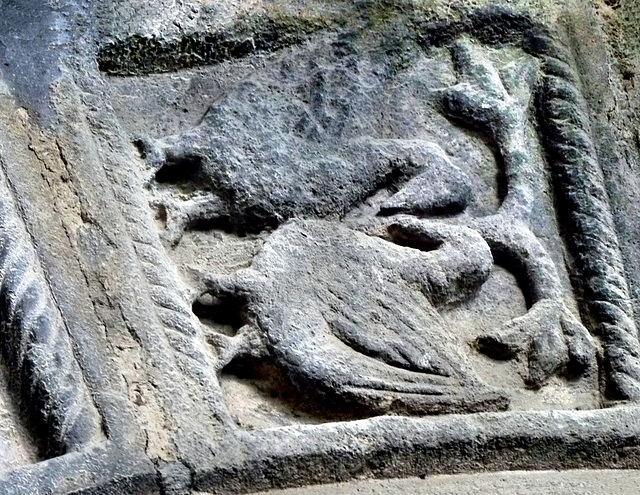Location
Lat, Lng: 50.579298, 7.226665
You can copy the above to your favourite mapping app.
Address: Alte Mittelalterliche Stadtmauer
You can copy the above to your favourite mapping app.
Address: Alte Mittelalterliche Stadtmauer
See also...
Keywords
Authorizations, license
-
Visible by: Everyone -
All rights reserved
-
139 visits
Remagen - Pfarrhoftor


One of the first printed records about this gate stated in 1859 "Of all old monuments in the Rhine valley, none as mysterious as the portal (...) near the church in Remagen".
The Pfarrhoftor (= Gateway to the parish close) still is enigmatic. It may have been erected for a nearby monastery, that centered around an St. Apollinaris shrine, it may have been in deed a gate to a parish close. Actually it known since the 17th century, when parts of it were found, walled in between the rectory and the encircling wall. The parts were recovered and like pieces of a puzzle joined together.
Though the cope stone was lost, the large arch was easy to reconstruct. Wether the smaller side portal originally was left or right is unclear.
The 22 carved reliefs here have triggered more than a dozend different theories. I will quote some. The carving style was not appreciated by the art-historians. Already Wilhelm Bode ("Geschichte der Deutschen Plastik") wrote in 1887 that the carver was "without any artistic ambition".
For me this portal has parallels in Linden and Goegging. All three portals are roughly carved - and enigmatic, blending christian, pagan and ancient icons. The only point, that is undisputed is, that the portal was erected in the second half of the 12th century.
It may be, that the reliefs, seen here, are just single icons, that are not interconnected to a certain "iconographic program". This is claimed by Paul Clement (1938), Georg Dehio (1933) and Josef Minn (1942). In 1947 Albert M. Koeniger published the results of his research, interpreting the reliefs as icons of eight (!) deadly sins as described by Bishop Burchard of Worms (965-1025), author of a canon law collection (aka "Decretum Burchardi").
Two birds under a tree.
Koeninger sees them as "geese battling for a shrub" and interpretes the scene as a symbol for envy ("invidia"). Other authors have identified the birds as partridges, standing for the knowledge of God, following the Physiologus.
The Pfarrhoftor (= Gateway to the parish close) still is enigmatic. It may have been erected for a nearby monastery, that centered around an St. Apollinaris shrine, it may have been in deed a gate to a parish close. Actually it known since the 17th century, when parts of it were found, walled in between the rectory and the encircling wall. The parts were recovered and like pieces of a puzzle joined together.
Though the cope stone was lost, the large arch was easy to reconstruct. Wether the smaller side portal originally was left or right is unclear.
The 22 carved reliefs here have triggered more than a dozend different theories. I will quote some. The carving style was not appreciated by the art-historians. Already Wilhelm Bode ("Geschichte der Deutschen Plastik") wrote in 1887 that the carver was "without any artistic ambition".
For me this portal has parallels in Linden and Goegging. All three portals are roughly carved - and enigmatic, blending christian, pagan and ancient icons. The only point, that is undisputed is, that the portal was erected in the second half of the 12th century.
It may be, that the reliefs, seen here, are just single icons, that are not interconnected to a certain "iconographic program". This is claimed by Paul Clement (1938), Georg Dehio (1933) and Josef Minn (1942). In 1947 Albert M. Koeniger published the results of his research, interpreting the reliefs as icons of eight (!) deadly sins as described by Bishop Burchard of Worms (965-1025), author of a canon law collection (aka "Decretum Burchardi").
Two birds under a tree.
Koeninger sees them as "geese battling for a shrub" and interpretes the scene as a symbol for envy ("invidia"). Other authors have identified the birds as partridges, standing for the knowledge of God, following the Physiologus.
- Keyboard shortcuts:
Jump to top
RSS feed- Latest comments - Subscribe to the comment feeds of this photo
- ipernity © 2007-2025
- Help & Contact
|
Club news
|
About ipernity
|
History |
ipernity Club & Prices |
Guide of good conduct
Donate | Group guidelines | Privacy policy | Terms of use | Statutes | In memoria -
Facebook
Twitter











Sign-in to write a comment.